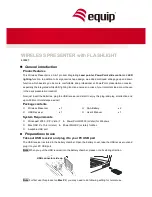
216
C H A P T E R 7
The Stereo Data Maker (SDM)
f
You can now use the
Edge Overlay
to register the nearest objects. The
Deviation Line
at the right-hand side of the grid’s centerline shows the
maximum deviation that is allowed for far objects. If this distance is
exceeded, you should reduce the camera spacing and redo the above
steps.
Unfortunately, this method does not work in all cases. Especially in macro
mode, your camera might not be able to focus at close distance while the
lens is in telephoto position. The SDM, on the other hand, can only capture
distances in telephoto position.
In this case, you are thrown back to using some old, well-known rules
for computing
Camera Spacing
and
Deviation factor:
f
For close-up work, the
Camera Spacing
should be lower than the dis-
tance between the lens and subject divided by 20. So, when your sub-
ject matter is 30 cm away from the lens, you should use a
Camera
Spacing
of less than 15 mm.
f
For “normal” subject distances, the
Camera Spacing
should be lower
than the distance to the nearest point of the subject divided by the
EFL
(35mm equivalent focal length) plus 20%. For example, if the distance
to the nearest point is 3 m, and the current EFL is set to 50 mm, an ac-
ceptable
Camera Spacing
would be 3000 / 50 + 20% = 72 mm.
f
The
Deviation factor
should be, in most cases, between 25 and 30. The
lower the value is, the larger the maximum acceptable deviation
dmax
will be, and the more difficult the viewing experience will be. The max-
imum acceptable deviation is computed by dividing the image width by
the deviation factor. After entering this factor, you can control the ac-
tual deviation with the grid
Deviation_H.GRD
and the
Deviation Line
as
described above.
If you want to play safe, you can “bracket” the
Camera Spacing,
e.g., by
following the “thirds” method (
Figure 7-9
). Later, when combining the im-
ages, you can select the best pair for achieving the desired 3D effect.
c
c/3
2*c/3
1
2
3
4
Figure 7-9
Given the computed camera spacing
c
,
four shots are sufficient for coverin g a
stereo basis between c/3 and 2*c. By
selecting two shots from this series,
you can decide between c/3 (1+2),
2*c/3 (3+4), c (2+3), 4*c/3 (1+3), 5*c/3
(2+4), and 2*c (1+4).
Содержание Camera
Страница 1: ......
Страница 2: ...The Canon Camera Hackers Manual ...
Страница 3: ......
Страница 4: ...Berthold Daum The Canon Camera Hackers Manual Teach Your Camera New Tricks ...
Страница 19: ...10 CH APTER 2 Cameras and Operating Systems ...
Страница 25: ...16 CH APTER 3 ...
Страница 85: ...76 CH APTER 4 Teach Your Camera New Tricks ...
Страница 213: ...204 CH APTER 6 ...
Страница 253: ...244 AP PENDIX ...
















































